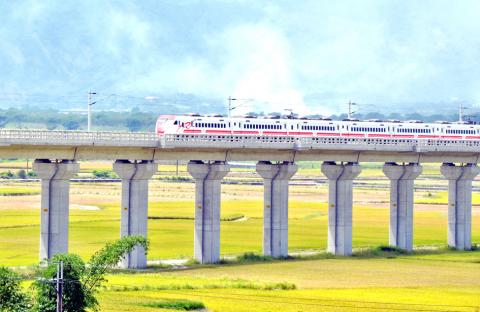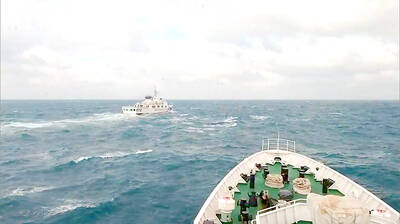The rail travel time between Taipei and Taitung has been shortened to three hours and 30 minutes following the launch of an electrified train service from Hualien to Taitung yesterday.
The government had initially planned to launch the electrified line in March next year.
President Ma Ying-jeou (馬英九), who made an electrified railway line between Hualien and Taitung one of his campaign promises in 2008, said at the inauguration ceremony yesterday that he decided to reduce the construction period of the project from seven years to five years after he took office.

Photo: CNA
He said that workers faced many difficulties during construction, including complicated geological conditions and inclement weather.
“Now I do not have to apologize to the people in Taitung County every time I come here to visit,” Ma said, adding that the needs of the people in the county have been largely ignored in the past and the electrified railway service is in part amending for that.
To ease demand for tickets on weekends, Ma said the Taiwan Railways Administration should consider offering discount tickets for tourists traveling on weekdays.
Taitung County Commissioner Justin Huang (黃健庭) said the number of tourists visiting Taitung has increased by 50 percent in recent years, but the electrified train service will only increase the transport capacity by a maximum of 40 percent.
He asked the agency to offer express trains from Taipei to Taitung without stopping at Hualien.
Minister of Transportation and Communications Yeh Kuang-shih (葉匡時) said that some sections of the current railway route have yet to be equipped with double tracks.
Because of this situation, trains have to wait to at Hualien, he said.
“Only when the double-track system is available on the entire route can a nonstop train from Taipei to Taitung be possible,” Yeh said, adding that the agency would this year start evaluating the possibility of turning the entire Hualien to Taitung railway line into a double-track system.
According to Yeh, the ministry is scheduled to begin the electrification of the South Link Railway by the end of this year, which he said was the “last mile” of the railway network that has yet to be electrified.
The driver of the pilot train service was 57-year-old Mai Ming-ji (麥明吉), a Puyuma Aborigine from Taitung. Having been a train driver for 22 years, Mai said he was honored to be the first conductor of the Puyuma Express after the Huanlien to Taitung railway line became electrified.
Passengers traveling to Hualien in the Puyuma Express can reach the destination in two hours after their electrification project is completed, whereas those traveling on the same express train can do so in 3.5 hours. The fastest train from Taipei to Taitung stops only at the Hualien and Yuli (玉里) stations en route.
In the past, passengers to Taitung had to switch from the electricity-powered trains to diesel-powered ones at Hualien Railway Station, with the estimated travel time at 4.5 hours.
The electrified railway line is about 166km and passes 28 stations.
The railway line along the nation’s west coast was completely electrified in 1979.
The agency said there will be two weeks of trial operations that ends on July 15.
Starting on July 16, all 17 sets of Puyuma Express trains will be in operation. The highest speed they can is reach 130kph.
Meanwhile, the Taitung County Government also worked with the agency to have various tourist attractions in Taitung painted on the body of one set of Puyuma Express carriages.
The county government is also to launch a Puyuma bus service on Tuesday next week.
Aside from meeting the needs of local residents for medical, education and food services, the bus is also to take visitors to all major tourist attractions in the downtown area.

Auckland rang in 2026 with a downtown fireworks display launched from New Zealand’s tallest structure, Sky Tower, making it the first major city to greet the new year at a celebration dampened by rain, while crowds in Taipei braved the elements to watch Taipei 101’s display. South Pacific countries are the first to bid farewell to 2025. Clocks struck midnight in Auckland, with a population of 1.7 million, 18 hours before the famous ball was to drop in New York’s Times Square. The five-minute display involved 3,500 fireworks launched from the 240m Sky Tower. Smaller community events were canceled across New Zealand’s

The Ministry of Foreign Affairs (MOFA) yesterday said it is closely monitoring developments in Venezuela, and would continue to cooperate with democratic allies and work together for regional and global security, stability, and prosperity. The remarks came after the US on Saturday launched a series of airstrikes in Venezuela and kidnapped Venezuelan President Nicolas Maduro, who was later flown to New York along with his wife. The pair face US charges related to drug trafficking and alleged cooperation with gangs designated as terrorist organizations. Maduro has denied the allegations. The ministry said that it is closely monitoring the political and economic situation

‘SLICING METHOD’: In the event of a blockade, the China Coast Guard would intercept Taiwanese ships while its navy would seek to deter foreign intervention China’s military drills around Taiwan this week signaled potential strategies to cut the nation off from energy supplies and foreign military assistance, a US think tank report said. The Chinese People’s Liberation Army (PLA) conducted what it called “Justice Mission 2025” exercises from Monday to Tuesday in five maritime zones and airspace around Taiwan, calling them a warning to “Taiwanese independence” forces. In a report released on Wednesday, the Institute for the Study of War said the exercises effectively simulated blocking shipping routes to major port cities, including Kaohsiung, Keelung and Hualien. Taiwan would be highly vulnerable under such a blockade, because it

UNRELENTING: China attempted cyberattacks on Taiwan’s critical infrastructure 2.63 million times per day last year, up from 1.23 million in 2023, the NSB said China’s cyberarmy has long engaged in cyberattacks against Taiwan’s critical infrastructure, employing diverse and evolving tactics, the National Security Bureau (NSB) said yesterday, adding that cyberattacks on critical energy infrastructure last year increased 10-fold compared with the previous year. The NSB yesterday released a report titled Analysis on China’s Cyber Threats to Taiwan’s Critical Infrastructure in 2025, outlining the number of cyberattacks, major tactics and hacker groups. Taiwan’s national intelligence community identified a large number of cybersecurity incidents last year, the bureau said in a statement. China’s cyberarmy last year launched an average of 2.63 million intrusion attempts per day targeting Taiwan’s critical